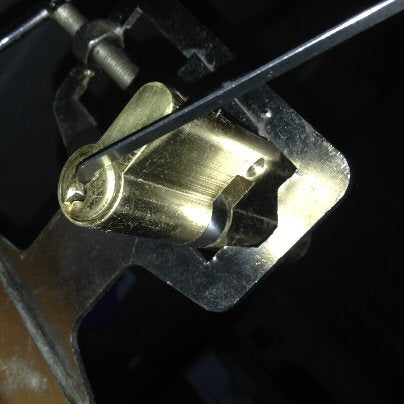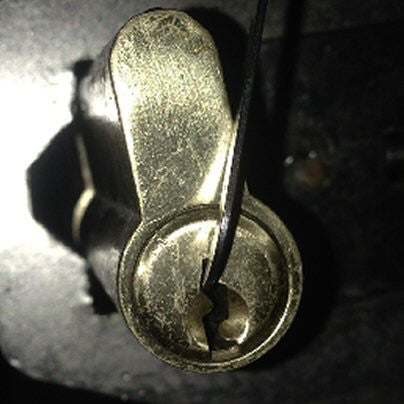Applying Tension in the Top of the Keyway - TOK Wrenching.
It used to be a novelty, but TOK Wrenching is now the Lock Picking Default!

Hello all
Every day I'll get at least one email asking: "What does TOK and BOK mean?" Do you know? If not, you're about to become a better lock picker. TOK stands for "Top of Keyway", and BOK, for "Bottom of Keyway", and when it comes to lock picking, TOK and BOK are referring to a type of tension tool used in those different parts of the keyway. Now we all know about applying tension from the bottom of the keyway, that's what most wrenches are designed for. But for top of keyway you need a different type of wrench; you need to know why, and you need to know now!
Personal taste goes a long way with picking locks. One of my close friends and fellow obsessive lock pickers, Rene, always starts with a TOK tension tool. It's his weapon of choice so to speak. He might end up with a BOK wrench, but he'll always start with a TOK version. When you have the information you'll make your own choices. But what are the differences, why should you get some TOK wrenches?
I'd say the main reason TOK wrenches work so well are because they free-up so much space in the lock. A BOK wrench tends to have a lot of metal in the lock. I'm sure everyone's familiar with a wrench-slip, where the tension tool turns slightly while you're picking - sometimes without you knowing - and causes the BOK tension tool to point upwards slightly in the plug. You can still pick like this, and many do, especially if a few pins are already set and you don't want to start again from scratch. But even when everything's dandy and the BOK wrench stays true, there's still a lot of material in the limited space of the inside of the lock, which might - and often does - restrict your ability to get to the pins, especially if you have a long key-pin or pins in the way. In such circumstances you need all the space you can get, and a TOK wrench has much, MUCH, less material in the lock than a BOK wrench. Now there is a sacrifice of sorts. Many of you will be familiar with using the BOK wrenches, and getting some leverage by using it as a fulcrum for your pick. You do this in much the same way that you do when using the wards to achieve leverage. And that would be my answer if you are using a TOK wrench, leverage can be obtained via the wards, so you can still get the leverage you might need, but without the length of metal a BOK wrench has in the lock. Everything is so magnified when picking locks that a BOK wrench is sometimes like having a steel girder in your lock. Not ideal.

TOK wrenches don't go all the way into the lock. If you look at the pictures of the wrenches and of the wrench in a lock, you'll see it's just a matter of mm's that go in the lock. The TOK wrench is designed to stop it going in any further and prevent it engaging the first pin. After that the lock is as clear as day - and the first time you try one, you'll be amazed - the lock is suddenly a huge cave with pins hanging down like giant stalactites. You feel like Ant-Man wandering around in the lock, working out what huge pin to move first! Well, maybe not so spacious, but everything's relative and the new found space is going to please you, I promise. And a lot of the time, it;s going to make picking the lock easier.
The other benefit of using a TOK wrench is to do with the axis of the lock's plug. If you look at a keyway you'll notice the space you insert the BOK wrench is well off center, whereas the space you insert the TOK wrench is pretty much central. Having a wrench at the BOK means when you apply tension you are not only applying rotational force, but you're also pushing against the true central axis of the plug in the lock. This causes - in a small but significant way - one end of the plug to be pulled down lower than the other, and the other higher, creating problems with the pins and them binding. The last thing you want to cause is problems with binding! A TOK wrench, being more central, is on the true axis of the plug, so you're applying the rotational force more evenly across the central axis of the plug, therefore binding the pins with equal force along the central axis from the first pin to the last. In short, a TOK wrench doesn't 'tilt' the plug as much as a BOK wrench.


Our 5 piece pry-bar TOK wrench set
Put simply, using a TOK wrench means there's more room in the lock for your lock pick, and a more precise application of tension. There's also times when you might not have the room around the outside of the lock to use
Our EIGHT PIECE TOK Wrench - Including a 2mm Wrench!
a conventional BOK wrench, things like door-frames can be problematic if the BOK wrench sticks out to the side, as they do. But most of all, TOK wrenches are another option, and having options is how you open more locks. To finish, a kit without a set of TOK wrenches, is far from complete, and doesn't give you the best chance of opening that damn lock!
Happy Picking
Chris.

